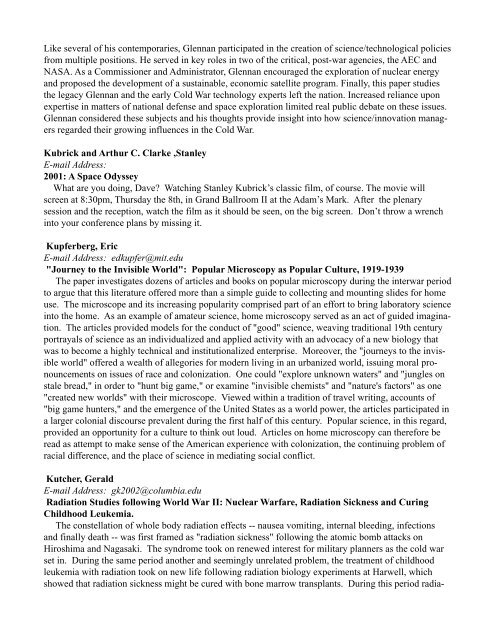Listing of Sessions and Abstracts of Papers - History of Science ...
Listing of Sessions and Abstracts of Papers - History of Science ...
Listing of Sessions and Abstracts of Papers - History of Science ...
Create successful ePaper yourself
Turn your PDF publications into a flip-book with our unique Google optimized e-Paper software.
Like several <strong>of</strong> his contemporaries, Glennan participated in the creation <strong>of</strong> science/technological policies<br />
from multiple positions. He served in key roles in two <strong>of</strong> the critical, post-war agencies, the AEC <strong>and</strong><br />
NASA. As a Commissioner <strong>and</strong> Administrator, Glennan encouraged the exploration <strong>of</strong> nuclear energy<br />
<strong>and</strong> proposed the development <strong>of</strong> a sustainable, economic satellite program. Finally, this paper studies<br />
the legacy Glennan <strong>and</strong> the early Cold War technology experts left the nation. Increased reliance upon<br />
expertise in matters <strong>of</strong> national defense <strong>and</strong> space exploration limited real public debate on these issues.<br />
Glennan considered these subjects <strong>and</strong> his thoughts provide insight into how science/innovation managers<br />
regarded their growing influences in the Cold War.<br />
Kubrick <strong>and</strong> Arthur C. Clarke ,Stanley<br />
E-mail Address:<br />
2001: A Space Odyssey<br />
What are you doing, Dave? Watching Stanley Kubrick’s classic film, <strong>of</strong> course. The movie will<br />
screen at 8:30pm, Thursday the 8th, in Gr<strong>and</strong> Ballroom II at the Adam’s Mark. After the plenary<br />
session <strong>and</strong> the reception, watch the film as it should be seen, on the big screen. Don’t throw a wrench<br />
into your conference plans by missing it.<br />
Kupferberg, Eric<br />
E-mail Address: edkupfer@mit.edu<br />
"Journey to the Invisible World": Popular Microscopy as Popular Culture, 1919-1939<br />
The paper investigates dozens <strong>of</strong> articles <strong>and</strong> books on popular microscopy during the interwar period<br />
to argue that this literature <strong>of</strong>fered more than a simple guide to collecting <strong>and</strong> mounting slides for home<br />
use. The microscope <strong>and</strong> its increasing popularity comprised part <strong>of</strong> an effort to bring laboratory science<br />
into the home. As an example <strong>of</strong> amateur science, home microscopy served as an act <strong>of</strong> guided imagination.<br />
The articles provided models for the conduct <strong>of</strong> "good" science, weaving traditional 19th century<br />
portrayals <strong>of</strong> science as an individualized <strong>and</strong> applied activity with an advocacy <strong>of</strong> a new biology that<br />
was to become a highly technical <strong>and</strong> institutionalized enterprise. Moreover, the "journeys to the invisible<br />
world" <strong>of</strong>fered a wealth <strong>of</strong> allegories for modern living in an urbanized world, issuing moral pronouncements<br />
on issues <strong>of</strong> race <strong>and</strong> colonization. One could "explore unknown waters" <strong>and</strong> "jungles on<br />
stale bread," in order to "hunt big game," or examine "invisible chemists" <strong>and</strong> "nature's factors" as one<br />
"created new worlds" with their microscope. Viewed within a tradition <strong>of</strong> travel writing, accounts <strong>of</strong><br />
"big game hunters," <strong>and</strong> the emergence <strong>of</strong> the United States as a world power, the articles participated in<br />
a larger colonial discourse prevalent during the first half <strong>of</strong> this century. Popular science, in this regard,<br />
provided an opportunity for a culture to think out loud. Articles on home microscopy can therefore be<br />
read as attempt to make sense <strong>of</strong> the American experience with colonization, the continuing problem <strong>of</strong><br />
racial difference, <strong>and</strong> the place <strong>of</strong> science in mediating social conflict.<br />
Kutcher, Gerald<br />
E-mail Address: gk2002@columbia.edu<br />
Radiation Studies following World War II: Nuclear Warfare, Radiation Sickness <strong>and</strong> Curing<br />
Childhood Leukemia.<br />
The constellation <strong>of</strong> whole body radiation effects -- nausea vomiting, internal bleeding, infections<br />
<strong>and</strong> finally death -- was first framed as "radiation sickness" following the atomic bomb attacks on<br />
Hiroshima <strong>and</strong> Nagasaki. The syndrome took on renewed interest for military planners as the cold war<br />
set in. During the same period another <strong>and</strong> seemingly unrelated problem, the treatment <strong>of</strong> childhood<br />
leukemia with radiation took on new life following radiation biology experiments at Harwell, which<br />
showed that radiation sickness might be cured with bone marrow transplants. During this period radia-
















